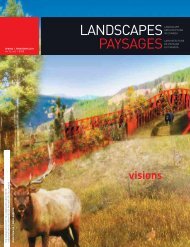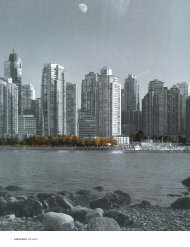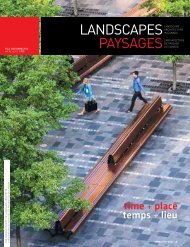trailblazers chefs de file - CSLA
trailblazers chefs de file - CSLA
trailblazers chefs de file - CSLA
Create successful ePaper yourself
Turn your PDF publications into a flip-book with our unique Google optimized e-Paper software.
CRITIQUE<br />
book info:<br />
Radical Gar<strong>de</strong>ning: Politics,<br />
I<strong>de</strong>alism and Rebellion<br />
in the Gar<strong>de</strong>n<br />
Author: George McKay<br />
Publisher: Frances Lincoln<br />
Limited Publishers, 2011<br />
ISBN: 978-0-7112-3030-9<br />
… gar<strong>de</strong>ning makes a <strong>de</strong>eply<br />
political statement.<br />
50 LANDSCAPES PAYSAGES<br />
READ BY SHIONA SOMMERVILLE<br />
MAKING A POLITICAL STATEMENT<br />
IN PARKS AND GARDENS<br />
THE ONGOING OCCUPY Wall Street protest,<br />
Spain’s indignados, and other off -shoots<br />
share common ground (Economist, Oct<br />
22/2011). If you have doubts, please read<br />
George McKay’s Radical Gar<strong>de</strong>ning for<br />
a compelling chronology of public parks<br />
and gar<strong>de</strong>ns as places for <strong>de</strong>mocratic<br />
discourse. McKay traces a continuum<br />
from the Speaker’s Corner in Hy<strong>de</strong> Park,<br />
London in use since the mid-19th century,<br />
to the 1970s “activist gar<strong>de</strong>ners” in vacant<br />
lots of Manhattan’s Losaida (Lower East<br />
Si<strong>de</strong>), to ‘80s punk concerts in the open<br />
air. McKay aims to legitimize the use of<br />
such spaces as sites – and in some cases,<br />
subjects – of political and social discontent.<br />
In so doing he creates a legacy for an<br />
array of counterculture political and social<br />
movements that marked the last century<br />
and a half to the present. To be clear,<br />
McKay’s book does not encompass recent<br />
Occupy protests – the page 10 photos of the<br />
Occupy Wall Street encampment in Liberty<br />
(Zuccotti) Park are my friend’s. But, to my<br />
mind, McKay’s chronology sets the current<br />
climate of protest as a natural outgrowth.<br />
FLOWER POWER<br />
In the introduction to his book, McKay<br />
i<strong>de</strong>ntifi es the gap between social and<br />
gar<strong>de</strong>ning histories. He quotes Martin<br />
Hoyles (The Story of Gar<strong>de</strong>ning) as saying<br />
that “social historians hardly ever mention<br />
gar<strong>de</strong>ns or gar<strong>de</strong>ning, and gar<strong>de</strong>n historians<br />
have little to say generally about politics.”<br />
McKay’s argument is that gar<strong>de</strong>ning makes<br />
a <strong>de</strong>eply political statement. In talking about<br />
“gar<strong>de</strong>ning,” McKay tackles a good number<br />
of land use activities that carry implicit<br />
political and social meanings. For example, he<br />
<strong>de</strong>scribes environmental activism and localism<br />
(the Findhorn community in Scotland), as<br />
well as acts of reclamation (guerrilla gar<strong>de</strong>ns)<br />
and commemoration (peace gar<strong>de</strong>ns). McKay<br />
explores the symbolic use of the gar<strong>de</strong>n<br />
and its elements in social movements, such<br />
as the plant choices of the 19th century<br />
British horticultural exhibitions which were<br />
rooted in the prevailing social hierarchy, the<br />
industry of Remembrance poppies, and the<br />
1960s’ “articulation of fl ower power.” All of<br />
this in mind, Radical Gar<strong>de</strong>ning is a potent<br />
remin<strong>de</strong>r for landscape architects that<br />
social movements and land use regimes are<br />
inextricably connected.<br />
As a case in point, McKay spends the better<br />
part of a chapter discussing the evolution of<br />
Ebenezer Howard’s Gar<strong>de</strong>n City movement.<br />
McKay traces the evolution of the Gar<strong>de</strong>n<br />
City from its earliest conception as a radical,<br />
i<strong>de</strong>alist and socialist new societal or<strong>de</strong>r<br />
to one that was tempered by practicality<br />
and corporate funding. McKay sees this<br />
evolution as both the movement’s strength<br />
and its weakness. Says McKay: The tie to<br />
corporations (Quaker Cadbury and Lever<br />
businesses) lent legitimacy, popularity and<br />
“serious consi<strong>de</strong>ration” to a movement<br />
that energized the professions of landscape<br />
architecture and urban planning (as it did<br />
for early childhood education, women’s<br />
suff rage, and more.) These are laudable<br />
achievements. However, McKay argues that<br />
there were stark diff erences between built<br />
communities such as Bourneville and Port<br />
Sunlight as “low-<strong>de</strong>nsity mo<strong>de</strong>l housing for<br />
the industrial worker” and Howard’s original<br />
interest in social improvement in the form<br />
of “an experimental community seeking a<br />
novel environmental or<strong>de</strong>r.” Whether or not<br />
you agree with McKay’s interpretation on this<br />
count, McKay makes a clear point that there<br />
are lessons to be learned in examining the<br />
social and political dynamics that spur our land<br />
use <strong>de</strong>cisions and lifestyles.<br />
THE NINETY-NINE PERCENT<br />
In his discussion of myriad movements, I<br />
believe McKay makes another point: that a<br />
social-gar<strong>de</strong>ning history is highly participatory<br />
and partisan, but also messy and locally varied.<br />
McKay does well to bring together diff use<br />
activities which have in common the use of<br />
parks, public spaces and parcels of land as loci<br />
for political and social <strong>de</strong>bate. To borrow the<br />
Occupy hallmark, McKay’s book <strong>de</strong>scribes a<br />
continuum of engagement of the 99%.<br />
ssommerville@post.harvard.edu






